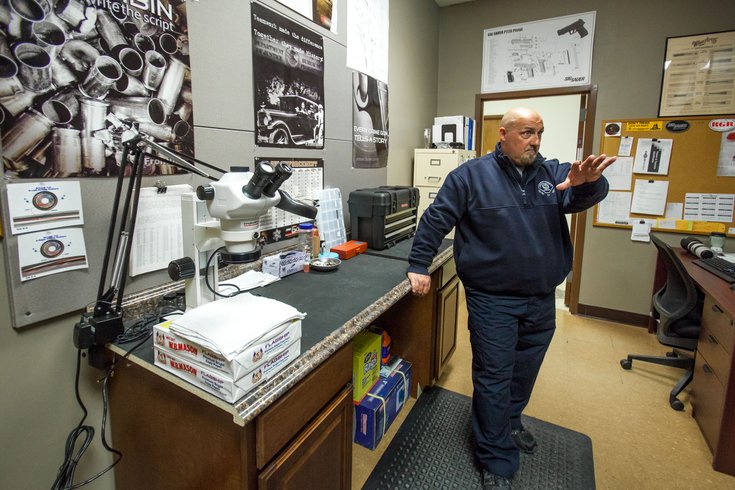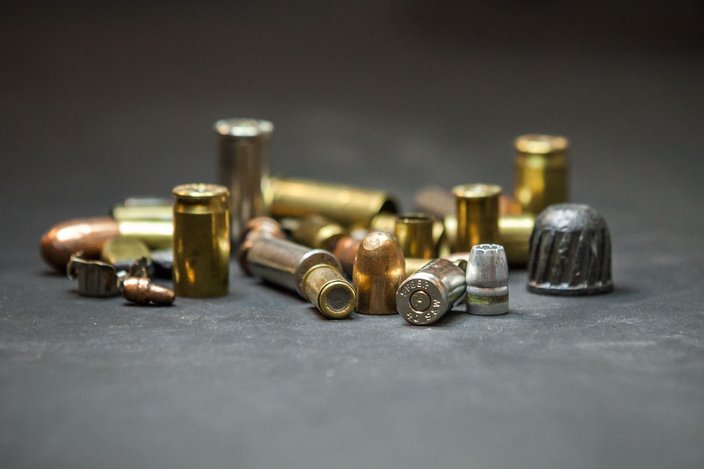In a room the size of a walk-in closet, a metallic box that resembles a desktop computer the size of a large suitcase sits on a desk next to its monitor.
Instead of a disk drive, themachine has an opening where crime scene shell casings are inserted.
“This door is going to open, an arm is going to swing out, and I’m going to enter this shell casing in,” said Salvator DiPaola, a ballistics expert with the
Camden County Police Department who demonstrated
how the machine worked on Thursday.
The machine is formally called the
Integrated Ballistic Identification System and is worth between $300,000 and $500,000, an amount funded through a federal grant, according to the department. It is a newly acquired investigative tool for the Camden police that can match bullet casings from crime scenes with guns entered into a national database. Within hours, DiPaola can match a crime scene’s shell casings with a gun connected to an individual or past crime, which can, in turn, focus an investigation’s attention toward a target.
It is another part of Camden’s attempt to reduce violent crime and murders. So far, the technology has found four potential matches in its first five weeks of operation, DiPaola said. The city also has ShotSpotter, which can pinpoint the exact location of gunshots and help police respond.
Casings from bullets are ejected from an automatic or semi-automatic gun when it is fired. When guns are used in crimes, the police often recover casings and examine them for evidence. The back of a casing has marks that are unique to certain models of guns and, on closer inspection, can read like fingerprints, identifying individual weapons.
When a firearm is discharged, it creates a unique impression, or "fingerprint," on each bullet casing. Thom Carroll/PhillyVoice
DiPaola started in Camden in the beginning of March, which is when the department also started using the machine. Previously, he worked for the state police for 26 years, he said. For five of those, he was a ballistics expert.
“[Camden] had mentioned the possibility they would start their own lab, and I mentioned, joking around, the possibility that I would be retiring soon,” DiPaola said, referring to a casual conversation from more than a year and a half ago. “I get a call, ‘Are you still interested in a job?’”
That call caused him to retire from the state police earlier this year and start working in Camden, he said.
Search criteria are selected, such as the type of gun and region, DiPaola said.
“Roughly, about after four hours, it is going to spit back out images to me,” he said. There are often 5,000 results or more that pop up, but, like a Google search, only the most relevant returns are focused on.
“If I find something I like, I’m going to put both [images] together,” DiPaola said, referring to the casings scanned in Camden and the potential match in the database. Then, he will use a tool that allows him to slide a bar to compare the images. It is the same visual aid that is used by news sites to show before and after pictures of a disaster area with a quick slide to the right or left.
On the wall are four of the matches DiPaola has made so far. They aren’t enough for police to go out and actually make an arrest, he said - a physical comparison has to be done by the state police to ensure accuracy first.
Camden is now one of about a half-dozen areas in New Jersey that have the machines. The New Jersey State Police have a machine, as do major cities like Philadelphia.
“The opportunity to have our own, located here, speeds up our process,” said Camden Assistant Chief of Police Orlando Cuevas. “We can turn around the information and use it.”
One of the sheets tacked to the wall is a possible hit from a gun connected with a homicide and aggravated assault, DiPaola said, adding that the match was pending verification and investigators were working on the case.
“Information goes to the detectives and they can do their investigation a lot faster,” said DiPaola.

 Thom Carroll/PhillyVoice
Thom Carroll/PhillyVoice
